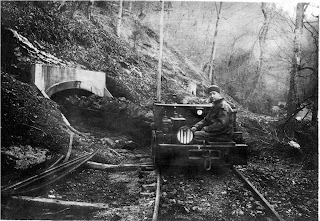The restored tipple dominates the site, as it did when the Stearns Coal and Lumber Company operated the coal camp from 1937 until 1962. Known as Blue Heron, or Mine 18, the company housed miners in company-owned houses and operated a company store to provide residents with their essentials.
Park Service photo
Coal was mined at several sites on both sides of the river and brought to the tipple by low tram cars.
Park Service photo
Tram cars unloaded the coal at the top of the tipple and mechanical screens inside sorted the coal by size and loaded it into railroad hopper cars for shipment to markets. The noise from the tipple was a constant in the coal camp, running 24 hours every day and stopping only for maintenance or emergency. Tipple operation also produced coal dust that drifted and settled over the site.
Park Service photo
Since tipple, track, houses, school, and church were all packed into a small area along the river, there could be no escape from the dust and noise.
While the next photo really doesn't apply to the tipple, I couldn't resist including a photo of "classmates" taken in the schoolhouse ghost structure.






Another interesting post. And I've learned a new word - "tipple" just meant alcoholic drink to me till now!
ReplyDeleteAh tipple. I had to look it up also. I like the photo of the kids best. Very interesting post Jim. And, what a beautiful place to be!
ReplyDeleteVery interesting -- thank goodness my corner of Appalachia seems to have no coal . . .
ReplyDeleteGreat shots and wonderful history. Glad it's still intact.
ReplyDeleteDarryl and Ruth :)